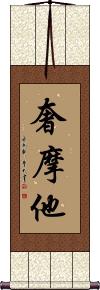Many custom options...
And formats...

The name Samatha in Chinese / Japanese...
Buy a Samatha calligraphy wall scroll here!
Personalize your custom “Samatha” project by clicking the button next to your favorite “Samatha” title below...
Samatha
Samatha
Not the results for Samatha that you were looking for?
Below are some entries from our dictionary that may match your Samatha search...
| Characters If shown, 2nd row is Simp. Chinese |
Pronunciation Romanization |
Simple Dictionary Definition |
奢摩他 see styles |
shē mó tā she1 mo2 ta1 she mo t`a she mo ta shamata |
More info & calligraphy: Samatha |
止 see styles |
zhǐ zhi3 chih tomeru とめる |
to stop; to prohibit; until; only (given name) Tomeru To stop, halt, cease; one of the seven definitions of 禪定 dhyāna described as 奢摩他 śamatha or 三摩地 samādhi; it is defined as 靜息動心 silencing, or putting to rest the active mind, or auto-hypnosis; also 心定止於一處 the mind centred, lit. the mind steadily fixed on one place, or in one position. It differs from 觀 which observes, examines, sifts evidence; 止 has to do with 拂妄 getting rid of distraction for moral ends; it is abstraction, rather than contemplation; see 止觀 In practice there are three methods of attaining such abstraction: (a) by fixing the mind on the nose, navel, etc.; (b) by stopping every thought as it arises; (c) by dwelling on the thought that nothing exists of itself, but from a preceding cause. |
止觀 止观 see styles |
zhǐ guān zhi3 guan1 chih kuan shikan |
奢摩他毗婆舍那 (or 奢摩他毗鉢舍那) śamatha-vipaśyanā, which Sanskrit words are intp. by 止觀; 定慧; 寂照; and 明靜; for their respective meanings see 止 and 觀. When the physical organism is at rest it is called 止 zhi, when the mind is seeing clearly it is called 觀 guan. The term and form of meditation is specially connected with its chief exponent, the founder of the Tiantai school, which school is styled 止觀宗 Zhiguan Zong, its chief object being concentration of the mind by special methods for the purpose of clear insight into truth, and to be rid of illusion. The Tiantai work gives ten fields of mediation, or concentration: (1) the 五陰, 十八界, and 十二入; (2) passion and delusion; (3) sickness; (4) karma forms; (5) māra-deeds; (6) dhyāna; (7) (wrong) theories; (8) arrogance; (9) the two Vehicles; (10) bodhisattvahood. |
靜力 静力 see styles |
jìng lì jing4 li4 ching li |
The power of abstract meditation. |
奢摩陀 see styles |
shē mó tuó she1 mo2 tuo2 she mo t`o she mo to shamata |
(Skt. śamatha) |
舍摩他 see styles |
shè mó tā she4 mo2 ta1 she mo t`a she mo ta shamata |
(Skt. śamatha) |
七滅諍法 七灭诤法 see styles |
qī miè zhēng fǎ qi1 mie4 zheng1 fa3 ch`i mieh cheng fa chi mieh cheng fa shichi metsujō hō |
saptādhikaraṇa-śamatha. Seven rules given in the Vinaya for settling disputes among the monks. Disputes arise from causes : from arguments; from discovery of misconduct; judgment and punishment of such; the correctness or otherwise of a religious observance. The seven rules are : 現前毘尼 saṃmukha-vinaya, face to face evidence, or appeal to the law; 憶念毘尼 smṛti-vinaya, witness or proof; 不痴毘尼 amūḍha-vinaya, irresponsibility, e.g. lunacy; 自言毘尼 tatsvabhavaiṣīya-vinaya, voluntary confession; 多語毘尼 pratijñākāraka-vinaya, decision by majority vote; 罪處所毘尼 yadbhūyasikīya-vinaya, condemnation of unconfessed sin by the 白四 or jñapticaturthin method, i.e. to make a statement and ask thrice for judgment; 草覆地毘尼 tṛṇastāraka-vinaya. , i.e. covering the mud with straw, i.e. in protracted disputes the appointment by each side of an elder to spread the straw of the law over the mud of the dispute. |
奢摩他觀 奢摩他观 see styles |
shē mó tā guān she1 mo2 ta1 guan1 she mo t`a kuan she mo ta kuan shamata kan |
śamatha (tranquility) method of meditation |
止觀倶行 止观倶行 see styles |
zhǐ guān jù xíng zhi3 guan1 ju4 xing2 chih kuan chü hsing shikan gugyō |
practice both śamatha and vipaśyanā side by side |
奢摩他毘缽舍那 奢摩他毘钵舍那 see styles |
shē mó tā pí bō shèn à she1 mo2 ta1 pi2 bo1 shen4 a4 she mo t`a p`i po shen a she mo ta pi po shen a shamata bipasshana |
śamatha-vipaśyanā |
修習止觀坐禪法要 修习止观坐禅法要 see styles |
xiū xí zhǐ guān zuò chán fǎ yào xiu1 xi2 zhi3 guan1 zuo4 chan2 fa3 yao4 hsiu hsi chih kuan tso ch`an fa yao hsiu hsi chih kuan tso chan fa yao Shushū shikan zazen hōyō |
Essentials of Practicing Śamatha and Vipaśyanā Meditation |
The following table may be helpful for those studying Chinese or Japanese...
| Title | Characters | Romaji (Romanized Japanese) | Various forms of Romanized Chinese | |
| Samatha | 奢摩他 | shē mó tā she1 mo2 ta1 she mo ta shemota | she mo t`a shemota she mo ta |
|
| Samatha | サマサ | samasa | ||
Successful Chinese Character and Japanese Kanji calligraphy searches within the last few hours...





